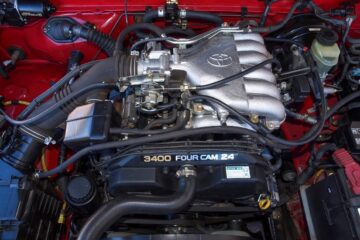The Toyota 5VZ-FE engine is a 3.4-liter V6 used in several Toyota models, including the 4Runner, Tacoma, T100, and Tundra. It is known for its durability, reliability, and strong performance in off-road and towing applications. One of the most frequently asked questions about this engine is: Is the 5VZ-FE an interference engine? The answer to this question is crucial for owners who want to understand the potential risks associated with timing belt failure.
What Is an Interference Engine?
Engines are categorized into interference and non-interference designs based on how the pistons and valves interact.
- Interference Engine: The valves and pistons occupy the same space at different times. If the timing belt breaks, the valves may remain open while the piston moves up, causing serious damage to the engine (bent valves, damaged pistons, or even broken cylinder heads).
- Non-Interference Engine: The pistons and valves do not share the same space, even if the timing belt fails. In this case, a broken belt will cause the engine to stop running but won’t cause internal damage.
Is the 5VZ-FE an Interference or Non-Interference Engine?
The Toyota 5VZ-FE engine is a non-interference engine. This means that if the timing belt snaps, the pistons and valves will not collide, and there will be no catastrophic damage to the engine’s internals. However, the engine will stall immediately, leaving you stranded.
Why Is the 5VZ-FE Non-Interference?
The 5VZ-FE’s design prevents the pistons from reaching the open valves even if the camshaft stops rotating due to a timing belt failure. This safety feature gives peace of mind, but timing belt maintenance is still crucial to avoid breakdowns.
Timing Belt Service Intervals and Replacement
Although the 5VZ-FE engine won’t suffer internal damage from a broken timing belt, replacing it at the correct intervals prevents sudden failures and ensures reliability.
Recommended Timing Belt Replacement Interval
- Toyota recommends replacing the timing belt every 90,000 miles (144,000 km) or every 6 years, whichever comes first.
- In harsh driving conditions (off-roading, towing, extreme temperatures), replacing it earlier is highly recommended.
Signs of a Worn Timing Belt
- Cracking, fraying, or missing teeth on the belt.
- Engine misfires or loss of power due to timing issues.
- Rattling or ticking noises from the timing belt area.
- Difficult starting or unexpected stalling.
Additional Components to Replace with the Timing Belt
When replacing the timing belt, it’s wise to service other components that rely on it.
Recommended Parts to Replace
- Water Pump – Since the water pump is behind the timing belt, replacing it prevents future leaks.
- Timing Belt Tensioner and Idler Pulleys – These ensure the belt stays tight and doesn’t slip.
- Camshaft and Crankshaft Seals – Prevent oil leaks that could damage the belt.
- Accessory Drive Belts – If worn, replacing them at the same time saves labor costs.
What Happens If the Timing Belt Fails?
If the timing belt breaks on the 5VZ-FE engine, you won’t face costly valve or piston damage. However, your engine will immediately shut down, leaving you stranded.
Effects of a Broken Timing Belt on the 5VZ-FE:
- Engine stalls immediately – The camshaft stops turning, preventing combustion.
- No internal engine damage – Since it’s non-interference, there’s no valve-piston collision.
- Vehicle becomes undrivable – Towing is necessary.
Conclusion: Is the 5VZ-FE a Safe Engine in Terms of Timing?
Yes! The Toyota 5VZ-FE is a non-interference engine, meaning a timing belt failure won’t destroy the engine. However, regular timing belt maintenance is still necessary to prevent breakdowns and keep your engine running smoothly.
Key Takeaways:
- The 5VZ-FE engine is non-interference – no piston-to-valve contact.
- A broken timing belt won’t damage the engine, but it will cause the car to stall.
- Replace the timing belt every 90,000 miles (144,000 km) for reliability.
- Change the water pump and tensioners when replacing the timing belt.
By staying on top of maintenance, you can ensure your Toyota 5VZ-FE engine continues to run reliably for many miles to come.

1 Comment
Kent · 30/12/2024 at 01:37
I have a 1998 Toyota T100 5VZ-FE V6 3400 and it is said to be non-interference, but it DOES have a timing belt that needs to be changed every 80,000 or so miles. My T100 has 250,000 miles and the timing belt, and water pump were just changed.